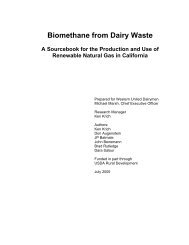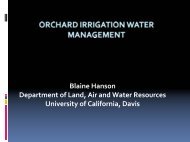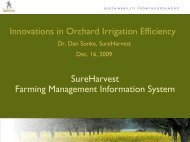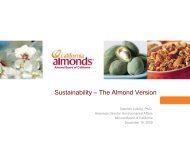Dairy Summit Summary - Sustainable Conservation
Dairy Summit Summary - Sustainable Conservation
Dairy Summit Summary - Sustainable Conservation
Create successful ePaper yourself
Turn your PDF publications into a flip-book with our unique Google optimized e-Paper software.
<strong>Sustainable</strong> <strong>Conservation</strong>’s <strong>Dairy</strong> <strong>Summit</strong>: Meeting <strong>Summary</strong><br />
May 2013<br />
group discussions to identify both barriers and opportunities to wide-scale adoption of these models in<br />
California.<br />
III.<br />
<strong>Summary</strong> of Speaker Presentations<br />
Adding Value: Nutrient Recovery and Fiber Products – Dr. Craig Frear, Washington State University’s<br />
Center for Sustaining Agriculture and Natural Resources<br />
Dr. Frear introduced a new technology he has been working to develop and commercialize that recovers<br />
ammonia nitrates from post-dairydigester effluent. Technologies that can help take excess nitrogen off<br />
of the farm are of interest in California due to the increased regulatory pressure around nitrate waste<br />
discharge requirements (WDRs). His technology is able to recover nutrients from dairy effluent without<br />
using chemicals. The stripped nutrients are then put into contact with sulfuric acid to alter the pH and<br />
create a concentrated liquid fertilizer (8% nitrogen). His demonstration facility is producing 2,300 gallons<br />
per day from 1,500 cows. While the fundamental economics of this technology are enticing, the costs<br />
associated with storing and transporting the final product and the uncertainty of pricing available for the<br />
end product create economic challenges. The key concerns brought up by audience members were, 1)<br />
the viability of this technology on flush dairies, 2) what to do with the remaining effluent, which will<br />
have relatively high concentrations of phosphates and salt, and 3) if the ammonia nitrate is exported<br />
from the dairy, what will the dairy use to fertilize its own crops?<br />
Dr. Frear further explained that most of the eight digesters in operation in Washington State are<br />
economically successful because they use additional substrates for co-digestion, adding to the electricity<br />
generation potential. Electricity prices in Washington State are low due to the abundance of cheap<br />
hydro-electric power. He noted that co-digestion revenues are starting to erode now that increased<br />
competition for the substrates is reducing tipping fees. Also, additional nutrient loading can occur with<br />
co-digestion and as a result developers need to pay attention to the nutrient content of added<br />
substrates.<br />
Adding Value: Co-digestion – Chris Pierce, Organic Management Solutions (OMS)<br />
Mr. Pierce provided an overview of what it takes to run a successful co-digestion business, emphasizing<br />
the industrial management approach that his company brings to anaerobic digesters. Co-digestion can<br />
optimize the energy output of a dairy digester. OMS’s goal is to provide third party management of<br />
manure, turning it into a profit center while allowing dairy farmers to stay focused on milk production.<br />
Mr. Pierce underscored the importance of understanding the customers (waste substrate providers) and<br />
providing a reliable service to them, as the market for their waste streams is competitive. He also<br />
stressed the need to treat the digester as a production system and to keep product quality consistent by<br />
making a recipe for the sludge and using an equalizing tank. Mr. Pierce acknowledged that the biggest<br />
liability in bringing on co-digestion is the potential to further complicate nutrient management for the<br />
dairy. Further challenges are the mismatch between contract periods with substrate providers and the<br />
time needed to pay off the upfront investment, and the risk that oversaturation will lead to substrate<br />
supply constraints, which depresses tipping fees.<br />
2







